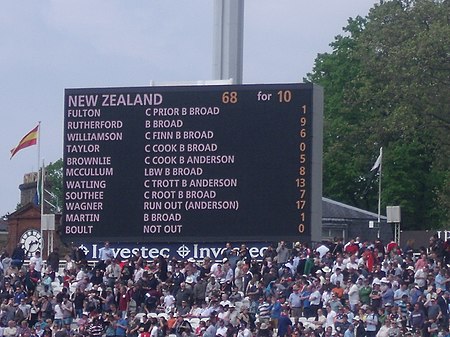Not out
Incricket,a batsman isnot outif they come out to bat in aninningsand have not beendismissedby theend of an innings.[1]The batsman is alsonot outwhile their innings is still in progress.
Occurrence[edit]
At least one batter is not out at the end of every innings, because once ten batters are out, the eleventh has no partner to bat on with, so the innings ends. Usually, two batters finish not out if the batting sidedeclaresinfirst-class cricket,and often at the end of the scheduled number of overs inlimited overs cricket.
Batters further down thebatting orderthan the not out batters do not come out to the crease at all and are noted asdid not batrather thannot out;[2]by contrast, a batter who comes to the crease but faces no balls isnot out.A batter whoretires hurtis considered not out; an uninjured batter who retires (rare) is consideredretired out.
Notation[edit]
In standard notation a batter's score is appended with anasteriskto show the not out final status; for example,10*means '10 not out'.
Effect on batting averages[edit]
Batting averagesare personal and are calculated as runs divided by dismissals, so a player who often ends the innings not out may get an inflated batting average, on the face of it.[3]Examples of this includeMS Dhoni(84 not outs inODIs),Michael Bevan(67 not outs inODIs),James Anderson(101 not outs in 237Testinnings), andBill Johnstontopping the batting averages on the1953 Australian tour of England.[3]
Using the formula of runs divided by innings understates performance for the following reasons:
- If not outs were counted as dismissals a usually high-scoring batter could bat briefly. They may regularly make a low score, not out, facing a low number of balls from abowlerand thus be penalized for factors out of their control.
- A batter will tend to be at their most vulnerable early in the innings before they have "got their eye in"; as a result, it may be a greater achievement to achieve two scores of 20 not out (i.e. averaging 40) than to make one score of 40, since in the latter instance the batter will only have had to deal with one set of variables (seeceteris paribus,all things remaining approximately equal).
These counterbalancing elements have been at the heart of the rationale of keeping the existing formula (runs divided by dismissals) in the 21st century among cricket statisticians, who have used this method of collecting batting averages since the 18th century, after some intervening controversy.[citation needed]
References[edit]
- ^"The Complete Guide To Understanding Cricket".Deadspin.2 November 2016.Retrieved2020-09-10.
- ^"Full Scorecard of England vs Australia 3rd T20I 2020 - Score Report | ESPNcricinfo".espncricinfo.Retrieved2020-09-10.
- ^abFrindall, Bill (13 April 2006)."Stump the Bearded Wonder No 120".BBC Online.Retrieved8 July2010.

